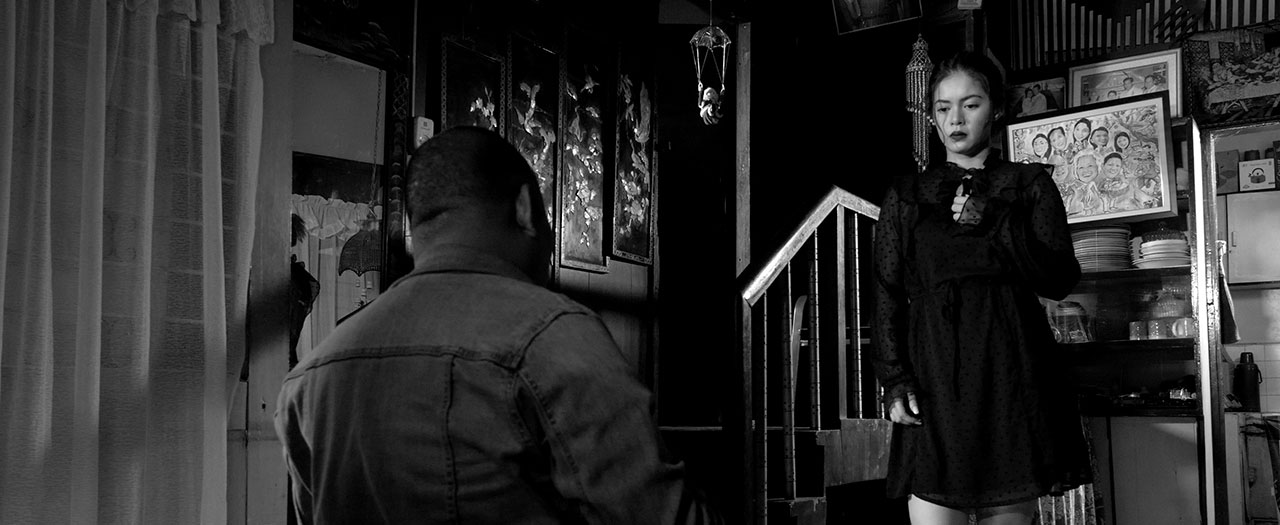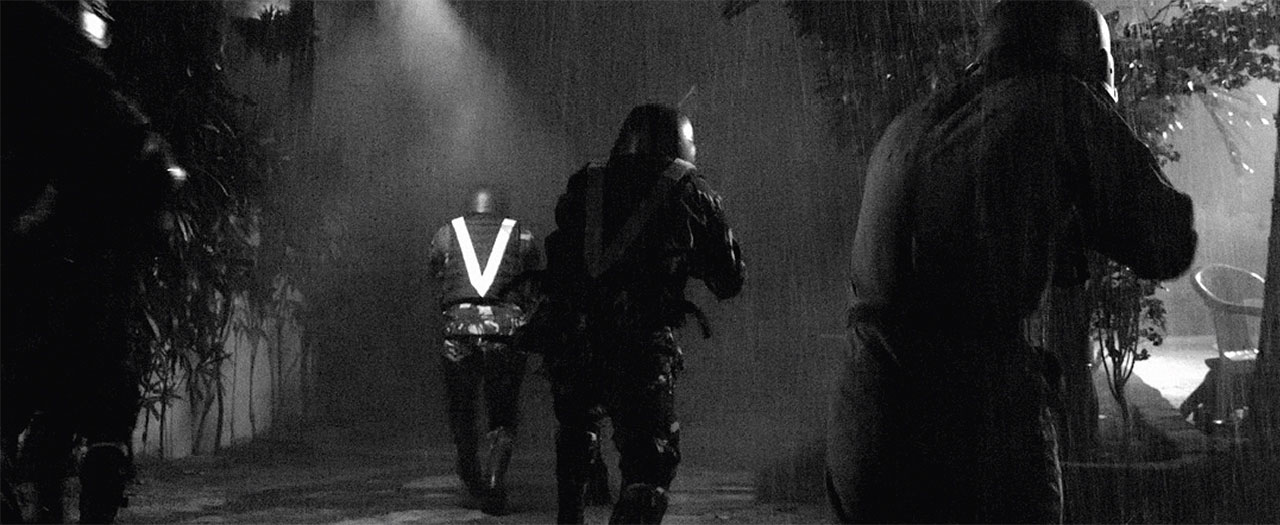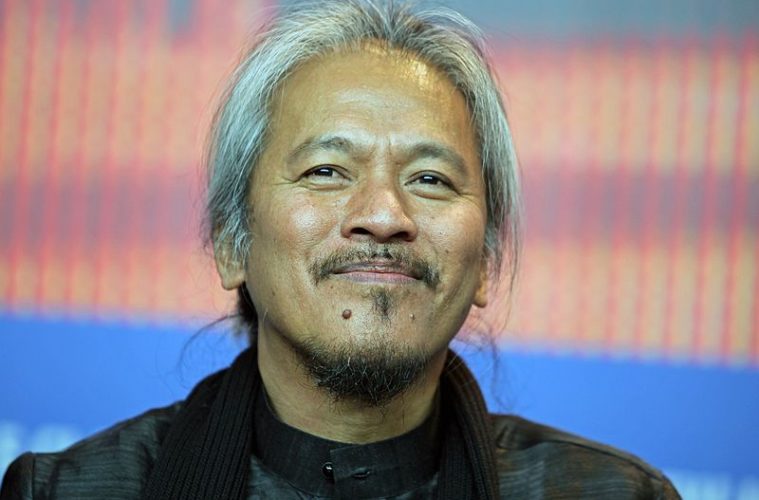Known for his epic–and epically long–films that examine the woeful past and troubled present of the Philippines, Lav Diaz has established an unmistakable name for himself and become a staple at A-list film festivals worldwide over the last decade.
He was awarded the Silver Bear Alfred Bauer Prize at the Berlinale for his 8-hour opus A Lullaby to the Sorrowful Mystery, the Golden Leopard at Locarno for the 5.5-hour From What Is Before, and won over Sam Mendes’ jury to take home the Golden Lion at the Venice Film Festival in 2016 for The Woman Who Left.
His latest feature, The Halt (4 hours and 36 minutes in case anyone is keeping score), premiered at the Directors’ Fortnight sidebar in Cannes earlier this year and screened recently at Filmfest Hamburg. It’s set in 2034, when volcanic eruptions have plunged Southeast Asia into darkness and the Philippines is ruled by a ruthless dictator bent on eliminating his political opponents.
We had the chance to speak with the celebrated filmmaker in Hamburg about his approach to filmmaking, streamers versus cinema, and his experiences at film festivals.
Your films often deal with the past and current troubles of the Philippines, but this time you look into the future. Can you talk about where the initial idea for The Halt come from?
While I was shooting Batang West Side in New Jersey and New York in 2000, one of my actors asked me for materials he could work on as a filmmaker, so I wrote this piece called 2019. I gave it to him and told him that it’s a science fiction story set in 2019, then I forgot about it.
Fast forward to the first quarter of last year, my cinematographer Larry Manda texted me and said he found this very interesting story I wrote. So I read it again, it was just a 15-page treatment. But it deals with so much of what’s happening right now in the country, including a dictator and people who are fed up and plotting his assassination, so there is an urgency to the story. The actor Piolo Pascual, who plays the assassin Hook in the film, then helped me find the investors and we just started pre-production. It came together organically.
For obvious reasons, I pushed the setting back to 2034. I mean, I could be accused of sedition if I set it in the present.
Do you mean there’s an official censorship?
It’s not censorship, but they have ways to make your life difficult.
Filmmaking has become increasingly difficult in countries which are turning authoritarian like Thailand, Brazil, and obviously China. Is it also getting trickier to make films the way you want to in the Philippines?
No. So far it’s not been a problem, because this government is so ignorant, they don’t really care about artists. They don’t think our work has any effect on people. So we’ve been spared thanks to this ignorance.
And at this point in your career, I guess finding financing is not a problem anymore.
That’s true. It’s kind of crazy that I have distributors in Europe now, they show my films in cinemas here, especially in France and Germany. So there’s a little money, and I don’t need big budgets for my films.

One of the themes you keep coming back to in The Halt is that the Filipino people don’t want to remember, that this is a nation with no memory. Can you talk about that?
It’s trauma, you know. More than 300 years of Spanish colonization, then came the Americans, then the Japanese and World War II, followed by 24 years of martial law under the Marcos regime and nine years under Gloria Macapagal Arroyo, all very corrupt governments. And now we have [Rodrigo] Duterte. So you can see how people might react.
It’s CPE (chronic traumatic encephalopathy) really, where people get so numb they just forget things. They don’t want to confront the past or examine it. Nowadays the public actually has a very positive view of Marcos, they believe the best years of their lives were the Marcos period. You tell them that’s the darkest period of our history and they’d look at you like, “What are you talking about?”
And the new president is studying that. He’s always propagating that Marcos is the best president the Philippines has ever had, that the country’s economy was the best during those years which can’t be farther from the truth. It’s been a very successful rehabilitation of Marcos’ name. That’s a classic example of how people forget.
Another major theme of the film is religion…
Yes, in places like South America or the Philippines religion is still very powerful, it’s a big part of our lives.
Where do you stand personally on religions? Are you suspicious of them?
Yes. If it’s up to me they would be eradicated. I mean religion gives people hope, it makes people believe in things they don’t understand by way of mythologies it creates. And people like Marcos, they take advantage of that. They realize myth-making is a powerful tool and people are susceptible to it. Of course religion has a very positive side, but the negative side is so overwhelming, especially now, when you can see clearly how the practice of myth-making is connected to religion.
Coming back to the filmmaking part, you are the writer, director, cinematographer, editor, and designer of The Halt. Do you prefer having this kind of comprehensive creative control or collaborating with others?
I would like to collaborate with other people but in the Philippines they are not always available. Everybody’s shooting all the time and I can’t offer them big money to make themselves available for me. So you learn to work on your own with the budget you have. I work with a small crew, there’s more mobility and flexibility that way and they understand my vision.
I don’t think the title The Halt is expressly referenced in the film. Can you talk about what it means?
Well, the Malay word I chose for the film’s title is “Hupa,” a word with a broad meaning. It means to stop, or to ebb like the waves, or to deafen something. So I chose that word to address the death of truth and morality. Or also the death of light, the ceasing of movement, the numbing of the mind, the death of everything. We couldn’t find a better word in English that approximates “Hupa,” so I agreed to calling it The Halt.
Are your films very scripted?
Yes, very much so. I mean we improvise on the set too. Sometimes the actors try to rephrase the lines on the set, that’s fine as long as the essence is still there. I write the script every day. I wake up at dawn and write the script for the day. When the rest of the team is up, they get their script at breakfast.
So when you talked about the early script for 2019, that was not a full script.
Yeah I expanded on the original story I wrote. The final script is so different from the original one. The same happened with Norte, the End of History. It was originally written by a friend, but I revised and made changes to it every day. All my co-workers know that’s how I work. The costume designer and the actors would wait in the morning for that day’s script. They call it the “Flying Paper.”
Why do you prefer to write this way?
What I look for is fluidity. And also this is an approach I developed through the years for financial reasons, because shooting often got protracted on my films. The 10-hour film Evolution of a Filipino Family, for example, I shot over 10 years. I worked two jobs to buy the 16mm film rolls. When I had enough money to buy 10 rolls, I would call my team and say “We can shoot now.” Then we would shoot for three days, and they’d have to wait another six months.
So every time we resumed shooting there’s a gap, the whole set-up was different, and you just had to revise and adapt. At some point this became my process. And I do like this spontaneity. Even during shooting, if I see something open up, I would stop the shoot to write some more. I like this flexibility. Of course, that involves a lot of waiting, which is also why I have to contain my crew on islands.

You always shoot on islands?
Well, I should say far-flung places. Part of it is also to try to better understand our country, our culture. In the Philippines, most films are made either near Manila or in the regions where the filmmakers come from. For me, I’d like to explore other parts of our culture. Every time we shoot on an island, I would go there first, explore the island and try to understand the place. My co-workers and I came to understand more about the Philippines through our shoots, because you see how people really live in these remote areas.
In your capacity as cinematographer, do you have a preference between film and digital?
I’ve struggled with that before, this purist thing. I passed that phase in the early 2000s. Before then, I couldn’t accept digital. But the fact is I didn’t have any money, and digital offered this chance to be emancipated from the tyranny of money. It’s how I could afford to do the long films. At the same time, I feel like filmmakers shouldn’t be dependent on such materials concerns, it should be the other way around. At the end of the day, cinema should be about the filmmakers and not the camera or the lights.
What about always shooting in black and white? Is that an aesthetic choice?
Yes, that is an aesthetic choice. I grew up watching a lot of black-and-white films. Eight movies a week in black and white from Hong Kong, the Philippines and Hollywood. I immersed myself in the universe of cinema that way when I was a kid. It was my form of escape.
Who would you say were your cinematic heroes or influences when you were growing up?
Well, back then it was just about enjoying the movies or escaping to another world for me. You watch these movies and imagine being in places likes Hong Kong, America or Italy. But it was just that, escapism.
When I got into college, I discovered Lino Brocka, a great Filipino filmmaker from the second golden age of Filipino cinema. Our teacher assigned us to watch his film Manila in the Claws of Light–it’s a politically charged, socially conscious film. And it made me realize that, oh, we can use cinema as a tool for change, for education. That’s when I realized cinema can be much more than just entertainment and started discovering the work of Ishmael Bernal, Mario O’Hara, other great Filipino filmmakers from that era.
Then the German Goethe Institute started inviting German filmmakers to the Philippines to conduct workshops and show us films from Europe. That was also the first time I was able to hold a 16mm camera in my hand. After college, by chance I was able to go to New York and work there, and I started digging deeper by watching more films in the libraries, at the Film Forum, the Anthology Film Archives. That was when I was really opened up.
What about your contemporaries? Is there anyone whose work you particularly admire?
I like the works of Pedro Costa, Jia Zhangke, Hou Hsiao-Hsien. Edward Yang as well. I see in them the commitment to filmmaking the way that I’m committed.
Your films are known for their length. Is time itself an element of your storytelling? Is the experience of time part of the design?
Yeah, I don’t want the storytelling to obscure the flow of life, the flow of time. Because cinema as we know it is more going from cut to cut, a montage. I want to work more like a novelist, where you can experience the expanse of time without manipulation, without obstruction. Kind of like jazz, where you can play the same motif forever in a fluid way.
Also, in the Southeast Asian culture, waiting is very important. We sit under the trees or lie in our beds the whole day, waiting for something to happen. That’s the Malay way. It’s not laziness or indolence at all. It’s part of our lives, because we’re so connected to the ways of nature, including the hot weather, the humidity, the storms, typhoons, floods and landslides.
Do you set out to do a project with an idea how long it should be?
No, I don’t think about the length. That comes during editing. After I finish a first cut, I’d think “Oh this one is going to be six hours.”

You are a very productive filmmaker. How much time do you typically spend on pre-production, shooting and post-production?
My production schedule used to be very protracted like I said. Nowadays, it’s usually three to four months for pre-production, plus another two months for shooting. Post production depends on the material. Some films are easy to cut. Others are more demanding. Sometimes you realize during editing that you have to go back to shoot some more. So that depends on the project.
Streaming services have become increasingly popular…
Yeah, my work is now streamed on MUBI and Grasshopper. It’s part of cinema now.
So you don’t think streamers are hurting cinema.
No. I always go back to what Bazin said: “We will use technology to understand the nature of cinema.” Cinema is still evolving.
I guess you are not a traditionalist in this regard.
No, for me that would be the death of cinema–if you’re a traditionalist and don’t want to move forward. Technology is there for the taking, why not use it?
Now something completely unrelated: I read that you’ve been invited to join the AMPAS in 2017. Are you an active voting member?
I’m a member but I didn’t vote.
Why not? Did they send you the screeners?
So many. My place was flooded with screeners. And I received invitations to events in New York and Hong Kong. But I’m lazy that way… and I also don’t believe in competition.
Film festivals are also a form of competition. Do you like them?
I love film festivals because it’s about propagating cinema. Some may say it’s elitist, but the culture of supporting art cinema comes from film festivals, so it’s good.
You’ve been to the biggest film festivals in the world…
I like the small ones better. I went to this film festival at a village with a small university in Croatia. Everyone was just hanging out and watching films. I like that.
No red carpets, I guess.
No no no, we were just hanging out, having coffee and beer, talking to the students. It was great. The discourse was great. I also went to Málaga two years ago, I like these small-scale festivals where it’s so intimate, you can actually talk about cinema.
You say that as someone who has won the Golden Lion and the Golden Leopard…
Yeah I appreciate those things, but sometimes big festivals can be dangerous, because people can forget about cinema and it becomes more about celebrity. It gets obscene at some point.
I love Venice, Berlin, Cannes for showing my films, but what I saw there is dangerous. It’s about celebrity and power. The big festivals capitulate too much to Hollywood, they feel pressured to put a certain percentage of Hollywood films in competition. Of course they have sidebar sections like Un Certain Regard, Directors’ Fortnight, Orizzonti and Forum, but at the same time, there’s this hierarchy between the sections. It’s unfortunate. Guys like me or Jia Zhangke got lucky. But there are other great filmmakers out there who need the exposure. I know a lot of great filmmakers who can’t get a chance to show their work anywhere. It’s a pity.
The Halt screened at Filmfest Hamburg and is seeking U.S. distribution.

